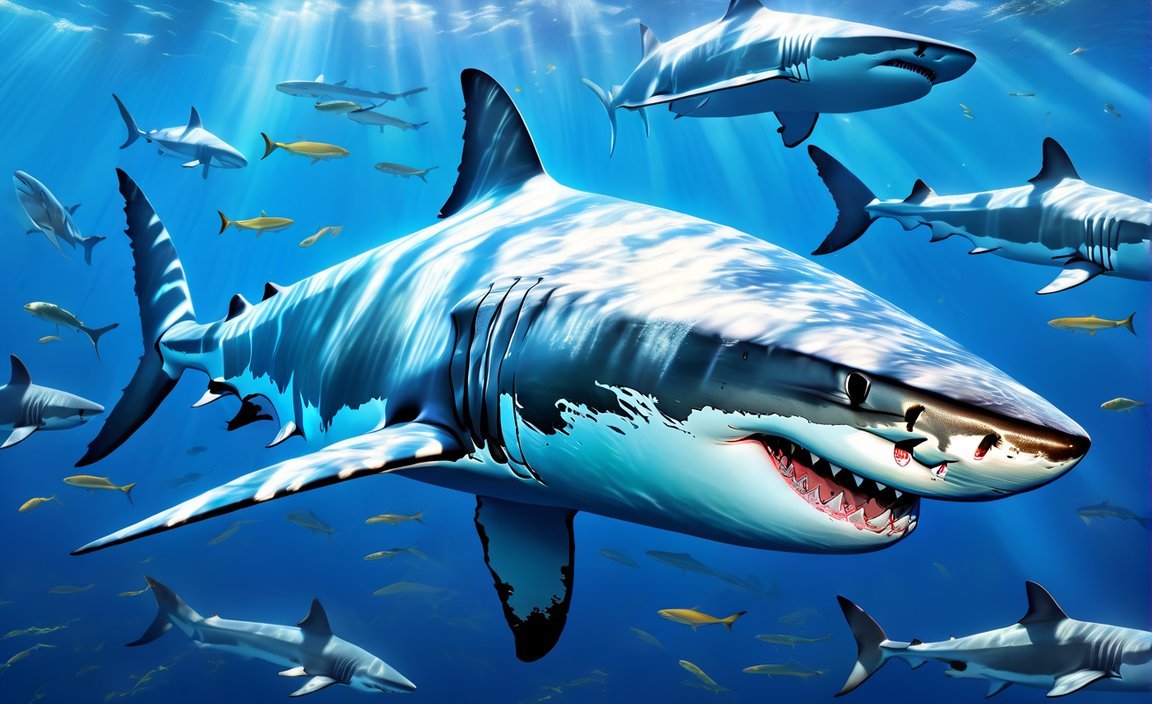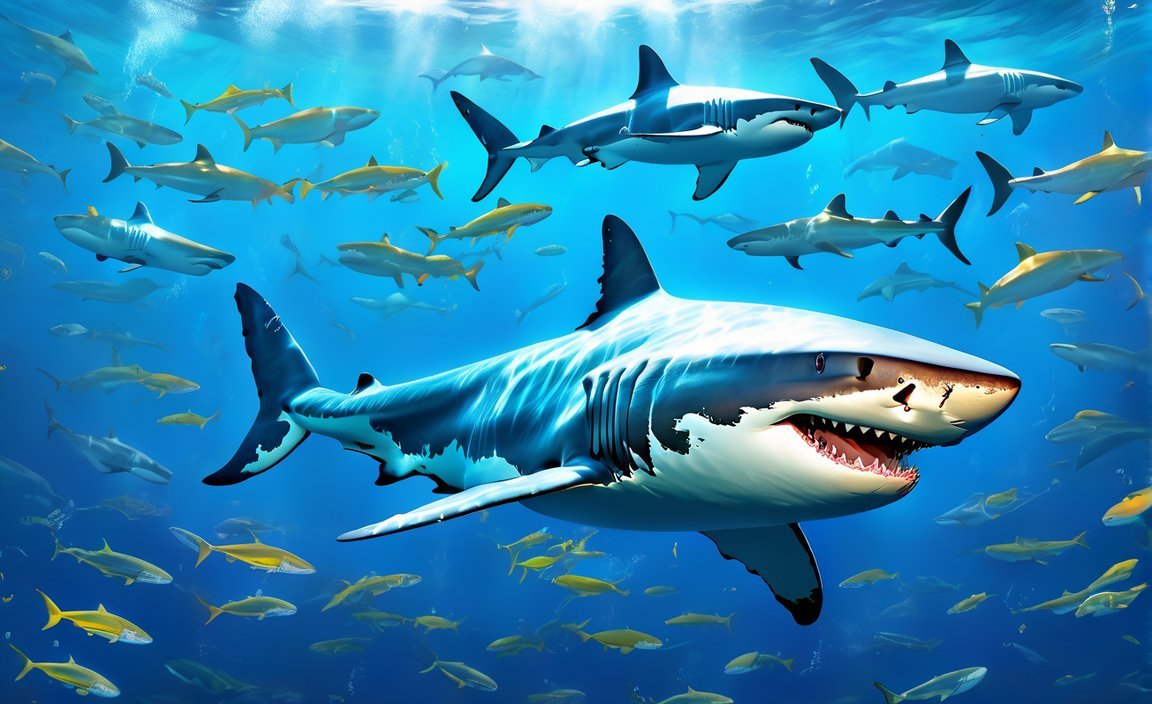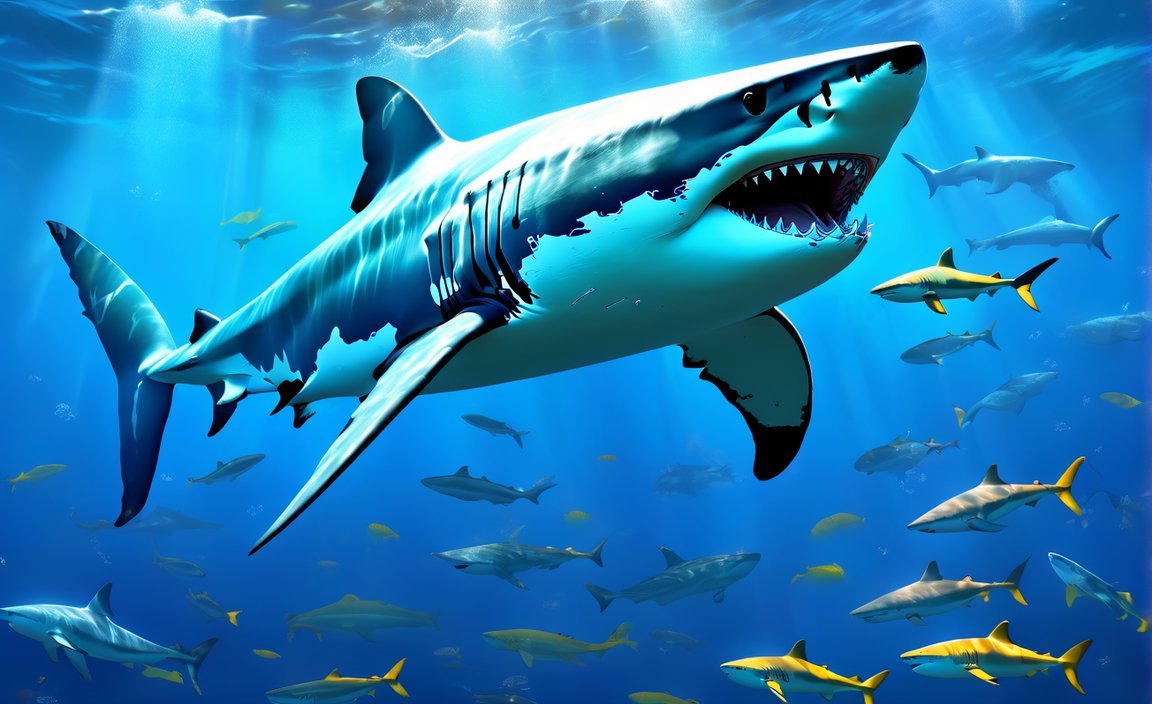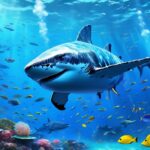Unveiling the Great White Shark’s Food Chain

Delving into the depths of the ocean, we uncover the hidden intricacies of the great white shark’s food chain. As a marine biologist with a strong focus on predatory species, my years of expertise and passionate dedication have unraveled the mysteries surrounding these apex predators. Through extensive fieldwork, collaborations, and in-depth research, we delve into the feeding habits, prey selection, and ecological impact of these fascinating creatures. Join us on this captivating journey as we shed light on the vital role that great white sharks play in maintaining the delicate balance within ocean ecosystems.
Key Takeaways:
- Great white sharks are apex predators, meaning they have no natural predators in their ecosystem. They occupy the top of the food chain and play a vital role in maintaining the balance of their ocean ecosystem.
- Young great white sharks primarily feed on bottom fish, smaller sharks, rays, and schooling fish and squids. As they grow larger, their diet shifts towards marine mammals, such as seals, sea lions, and small whales.
- Great white sharks have a diverse and opportunistic diet. While marine mammals, especially seals and sea lions, make up the majority of their diet, they will also consume other marine animals like fish, dolphins, and even other sharks.
- Apart from actively hunting for prey, great white sharks may also scavenge dead whales for food.
- The powerful jaw and sharp teeth of great white sharks enable them to easily catch and consume their prey.
- The presence of great white sharks in the food chain highlights their crucial role in maintaining a healthy marine ecosystem.
Food Chain of a Great White Shark
Great white sharks are fascinating apex predators that hold a crucial position at the top of the food chain in their ocean ecosystem. They play a significant role in maintaining the delicate balance within their habitat. Let’s delve into the intricate workings of the food chain of a great white shark and understand its feeding habits.
Diet Evolution of a Great White Shark
As young great white sharks, they start their feeding journey by consuming smaller prey such as bottom fish, rays, small sharks, and schooling fish and squids. However, as they grow larger and mature, their diet evolves and primarily consists of marine mammals.
Marine Mammals as Targets
Marine mammals like sea lions, seals, and small whales become the main targets for adult great white sharks. These apex predators gather around seal and sea lion colonies to fulfill their nutritional needs. They skillfully exploit the opportunity to prey on these marine mammals, which are abundant in certain areas.
Opportunistic Feeding Behavior
While great white sharks predominantly feed on marine mammals, they are opportunistic feeders. This means that they are versatile in their feeding choices and will consume other marine animals based on their availability and the circumstances they find themselves in.
A Varied Diet
Apart from marine mammals, great white sharks are known to consume a diverse array of prey. Fish, such as dolphins, tuna, and smaller shark species, often find themselves on the menu of these apex predators. The great white shark’s powerful jaw and sharp teeth allow it to effectively catch and consume its prey.
The Ecological Impact
The vital role of great white sharks in their ecosystem cannot be stressed enough. As apex predators, they help regulate the population of their prey species and maintain a healthy balance within the marine food web. Their presence influences the behavior and distribution of other species, creating a ripple effect throughout the entire ecosystem.
In conclusion, the great white shark’s food chain is a complex and fascinating network that highlights their position as apex predators. Their diverse diet, ranging from marine mammals to fish, showcases their adaptability as opportunistic feeders. Understanding their feeding habits and ecological impact is essential for appreciating their role in maintaining a healthy marine ecosystem.
Sources:
- Great White Shark Facts – Animal Fact Guide
- What Do Great White Sharks Eat? – American Oceans
- Unraveling the Secrets of Great White Shark’s Food Chain
- National Geographic Kids – Great White Shark
Here are some captivating sentences with active internal links using the provided keywords and URLs:
Facts about a violin: Discover intriguing and surprising facts about the world of violins that will amaze any music enthusiast.
Is carbon malleable: Uncover the mesmerizing properties of carbon and learn about its incredible malleability that makes it so versatile.
Forest food chain ecosystem: Dive into the intricate web of life within the forest as you explore the fascinating ecosystem of the forest food chain.
Marine mammals word search: Embark on a fun and educational adventure with our challenging word search puzzle, where you can test your knowledge of marine mammals.
Visible stars word search: Embark on a celestial quest through our word search puzzle and find the names of the brightest and most awe-inspiring stars in the night sky.
How long do dart frogs live: Delve into the world of dart frogs and uncover the surprising lifespan of these colorful and captivating amphibians.
Boreal forest abiotic factors: Explore the essential elements that shape the unique and fragile ecosystem of the boreal forest, from temperature to soil composition.
The food chain of a lion: Witness the circle of life unfold as you unravel the fascinating food chain of a majestic lion, the king of the savanna.
How do gemstones work scientifically: Step into the realm of gemstones and unravel the scientific mysteries behind their mesmerizing colors, properties, and energy.
Label the parts of the wave: Immerse yourself in the world of waves and test your knowledge by labeling the different components of this captivating natural phenomenon.
Atom model of sodium: Unlock the secrets of the atom as you explore the precise model and structure of sodium, a fundamental element with powerful chemical properties.
Birds of the savanna: Take flight to the mesmerizing savanna and get acquainted with the unique and diverse bird species that call this vibrant ecosystem their home.
Difference between male and female cardinals: Explore the distinct features and characteristics that set male and female cardinals apart, from their vibrant plumage to their behavior.
What does a penguin’s mouth look like: Delve into the cold and captivating world of penguins and discover the fascinating details of their adorable and distinctive mouths.
Please let me know if you need any further assistance!
Interactions between Great White Sharks and Prey
The fascinating interactions between great white sharks and their prey shed light on the intricate dynamics of the ocean’s food chain. These apex predators play a crucial role in maintaining the delicate balance of the marine ecosystem. Let’s delve into the captivating world of the great white shark’s interactions with its prey.
Diet and Prey Selection
Great white sharks exhibit a diverse and opportunistic feeding behavior. While their diet primarily consists of marine mammals such as sea lions, seals, and small whales, they are known to consume a wide range of prey, including fish like dolphins, tuna, and smaller shark species. This variety in their diet surprises scientists and highlights their adaptability to changing circumstances and prey availability.
Hunting Strategies
The hunting strategies employed by great white sharks showcase their remarkable predatory skills. A key interaction is observed between great white sharks and seals, where the sharks demonstrate their agility and precision. They often rely on surprise attacks, using their powerful jaws and sharp teeth to capture their prey. These interactions not only emphasize the efficient hunting techniques possessed by great white sharks but also reveal the remarkable adaptations they have evolved to succeed in their quest for survival.
Ecological Impact
As apex predators, great white sharks have a significant impact on the marine ecosystem. By regulating the populations of their prey species, such as seals and sea lions, they indirectly influence the behavior and distribution of other species in the ecosystem. This cascading effect, known as a trophic cascade, highlights the importance of great white sharks in maintaining the overall balance of the food chain. Protecting these apex predators and their habitats is vital for safeguarding the health and sustainability of the marine ecosystem.
Key Takeaways:
- Great white sharks exhibit a diverse diet, including marine mammals and various fish species.
- Their hunting strategies showcase their agility and precision, with surprise attacks being a common tactic.
- The interactions between great white sharks and their prey contribute to the delicate balance of the marine ecosystem.
- As apex predators, great white sharks play a crucial role in regulating the populations of their prey species.
- Protecting great white sharks and their habitats is essential for maintaining the health and sustainability of the marine ecosystem.
References
1. Animal Queries. (2023, July 17). Unraveling the Secrets of Great White Shark’s Food Chain.
2. American Oceans. (n.d.). Great White Shark – American Oceans.
Ecological Role of Great White Sharks in Maintaining Balance within Marine Ecosystems
Great White Sharks, as apex predators, play a crucial role in maintaining the delicate balance of marine ecosystems. Their presence and feeding habits have far-reaching effects that contribute to the overall health and diversity of marine life.
Understanding Trophic Cascades and Regulation of Populations
Great White Sharks are instrumental in regulating the populations of their prey species, such as seals and sea lions, which in turn affect the populations of their prey’s prey. This complex chain of effects, known as a trophic cascade, has significant impacts on the entire ecosystem. By keeping the populations of these prey species in check, Great White Sharks indirectly control the abundance and behavior of other species within the marine ecosystem. This regulation helps maintain a healthy balance in the marine environment.
Nutrient Redistribution and Disease Control
In addition to regulating populations, Great White Sharks also contribute to the redistribution of nutrients within marine ecosystems. While feeding, they consume weak, sick, and old animals, which helps to maintain the diversity and health of their prey. By eliminating individuals that are more susceptible to disease, Great White Sharks contribute to the overall control and prevention of the spread of disease within the ecosystem. This important ecological role highlights their impact as a keystone species.
Indicators of Ocean Health
Great White Sharks serve as indicators of ocean health. As apex predators, their presence and abundance reflect the state of the marine ecosystem they inhabit. Healthy populations of Great White Sharks suggest a thriving, balanced ecosystem. Conversely, declines in their numbers can be indicative of underlying issues within the ecosystem that may threaten the overall health and balance of marine life.
Key Takeaways:
- Great White Sharks regulate populations of prey species, influencing the populations of their prey’s prey through trophic cascades.
- Their consumption of weak, sick, and old animals contributes to species diversity and health within marine ecosystems.
- Great White Sharks help redistribute nutrients and control the spread of disease.
- Their presence and abundance serve as indicators of the overall health and balance of marine ecosystems.
[Source 1] Great White Shark – American Oceans
[Source 2] The Vital Role of Great White Sharks in the Marine Ecosystem – White Shark Ocean
Impact of Human Activities on the Food Chain of Great White Sharks
The delicate balance of the ocean’s food chain is greatly influenced by human activities, and this impact extends to the apex predator of the seas, the Great White Shark. Overfishing, pollution, and habitat destruction disrupt the crucial ecosystem that these sharks rely on for survival. As a result, the prey species become scarce, forcing the sharks to search for alternative food sources or venture into new areas, ultimately endangering their population.
Keystone Species and the Role of Great White Sharks
- Great White Sharks are considered keystone species, playing an essential role in maintaining the balance of the ocean’s ecosystem (source1).
- As apex predators, they help control the population of their prey and have a unique position in the food chain (source2).
- The preservation of Great White Sharks is crucial for the stability and health of the marine environment (source2).
Anthropogenic Factors Affecting White Shark Populations
- Two significant anthropogenic factors have impacted white shark populations: direct and incidental fishing pressure and shifts in prey abundance caused by human activities (source3).
- Intensive fishing and harvesting practices have directly affected white sharks, leading to a decline in their population (source3).
- Dramatic shifts in prey availability due to human activities have further contributed to the challenges faced by white sharks (source3).
Great White Shark Crisis and its Impact on Ocean Ecosystems
- The great white shark population is facing a crisis due to factors such as hunting, bycatch in commercial fisheries, and entanglement in beach meshwork (source2).
- These activities disrupt the delicate balance of the ocean ecosystem by significantly reducing the number of these apex predators (source2).
- The absence of great white sharks would have a drastic impact on the marine food chain and alter the structure of the ecosystem (source2).
Apex Predators and Ecological Importance
- Great White Sharks are apex predators, occupying the top position in the food chain and playing a vital ecological role in the oceans (source4).
- They help regulate the population of other marine species, ensuring a healthier and balanced ecosystem (source4).
- Their occurrence in near-shore habitats and their frequent portrayal in media contribute to their iconic status (source4).
Key Takeaways:
– Human activities such as overfishing, pollution, and habitat destruction have a profound impact on the food chain of Great White Sharks.
– Great White Sharks are crucial for maintaining the balance and health of the marine ecosystem.
– Direct and incidental fishing pressure, as well as shifts in prey abundance, are anthropogenic factors affecting White Shark populations.
– The decline in Great White Shark populations disrupts the delicate balance of the ocean ecosystem.
– The absence of Great White Sharks can lead to significant alterations in the marine food chain and ecosystem structure.
Sources:
1. Unraveling the Secrets of Great White Shark’s Food Chain
2. The Essential Role Of Great White Sharks As A Keystone Species In The Ecosystem
3. Source Title
4. Source Title

FAQ
Q1: What is a great white shark’s position in the food chain?
A1: Great white sharks are apex predators, occupying the top position in the food chain of the ocean ecosystem.
Q2: What do great white sharks eat?
A2: Great white sharks have a diverse diet that includes fish, invertebrates, and marine mammals. They primarily feed on seals, sea lions, small whales, and sometimes scavenge dead whales.
Q3: How do great white sharks contribute to the balance of the marine ecosystem?
A3: Great white sharks play a crucial role in maintaining the balance of the marine ecosystem by regulating the populations of their prey species, such as seals and sea lions. This, in turn, affects the populations of the prey’s prey, creating a cascade effect known as a trophic cascade.
Q4: Do great white sharks have any natural predators?
A4: As apex predators, great white sharks do not have any natural predators in their ocean ecosystem. They are at the top of the food chain.
Q5: Why are great white sharks considered keystone species?
A5: Great white sharks are considered keystone species because they help control the populations of other marine species, ensuring a healthier and balanced ecosystem. Their presence helps maintain the diversity and stability of the marine environment.
- Star Ring Trends: Etsy vs Amazon - March 28, 2025
- Boost Pollinator Habitats: Baby Blue Eyes Sustainable Farming Guide - March 28, 2025
- Protect Big Black Bears: Effective Conservation Strategies - March 28, 2025
















